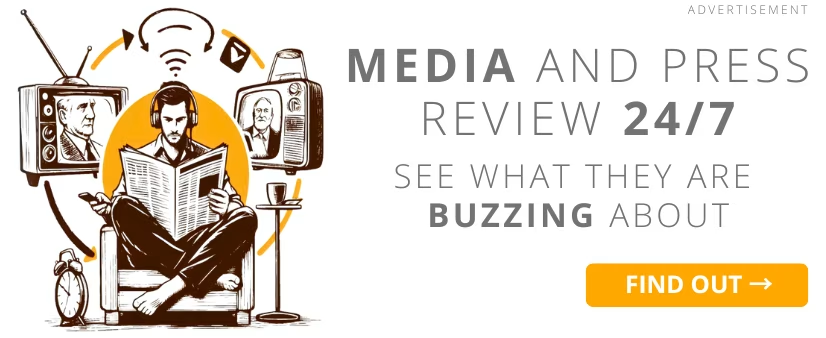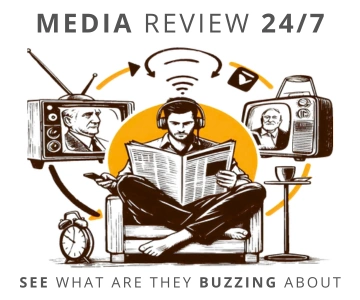 illustration: Bing AI
illustration: Bing AITrust in journalism in 2025 has reached a historic low – only 41% of surveyed media leaders expressed optimism about the industry`s future. This marks a 19 percentage point drop compared to 2022. Key challenges identified by respondents include political attacks, societal polarization, and the growing dominance of alternative media ecosystems.
The declining popularity of traditional media in favor of content created by influencers and media personalities has been ongoing for years. This trend is particularly visible among audiences under 30, where 37% regularly consume news published by online creators. This shift has serious implications for how society perceives the credibility of information. Simultaneously, traditional media, instead of competing, increasingly collaborates with influencers to reach younger audiences.
The Battle for Visibility in the Age of AI
The integration of artificial intelligence into search systems is reshaping the media landscape. According to the report “Journalism, Media, and Technology Trends and Predictions 2025,” 74% of publishers are concerned about losing search traffic, especially as AI generates news summaries, reducing clicks to source websites.
Google Discover, while growing as a traffic source (+12%), does not compensate for losses from other platforms, such as Facebook (-67% traffic over two years) or Twitter (-50%). Publishers also face new players like ChatGPT Search and Perplexity, which introduce revenue-sharing models favorable to select publishers but exclude smaller newsrooms.
- Example of technology impact: ChatGPT Search, launched in late 2024, delivers licensed content from reputable publishers like News Corp. Publishers signing such agreements receive preferential treatment, helping them maintain website traffic.
New Business Models: Opportunities and Risks
Subscription revenue remains the primary pillar of media funding – 77% of publishers identify it as a significant income source. However, subscriber growth is slowing, forcing publishers to explore new solutions. The report shows that publishers increasingly turn to diversified revenue streams such as events, partnerships with AI platforms, and donations.
| Revenue Source | Percentage of Publishers Considering Important |
|---|---|
| Subscriptions | 77% |
| Display Advertising | 69% |
| Events | 48% |
| AI Platforms | 36% |
| Donations | 19% |
Many publishers are investing in innovative products like audio apps, games, or educational platforms. An example is The Guardian`s culinary app “Feast,” which attracts new audiences by offering specialized content within a subscription model.
Changing Relationships with Platforms
Relationships between publishers and tech giants like Google, Apple, or OpenAI are becoming increasingly complex. 31% of respondents plan to strengthen collaboration with AI platforms, while a similar percentage seeks to limit such partnerships to reduce dependency on external partners.
- Platforms in focus:
- YouTube and TikTok (+52 and +48 net points in publisher evaluations) are identified as channels of growing importance.
- Meanwhile, Facebook (-42) and X (Twitter) (-68) are losing significance among publishers, prompting investments in alternative distribution channels.
The Role of Personalities and Influencers
Internet creators are increasingly competing with traditional media. In the US, 21% of respondents report regularly consuming news from influencers. In Europe, young creators like Hugo Travers in France or Jordan Shanks in Australia attract millions of followers with their authentic approach.
However, concerns about content quality are rising – according to UNESCO, 62% of influencers do not verify information before publication. Nonetheless, many newsrooms see this as an opportunity to collaborate and reach new audience groups.
The full report "Journalism, Media, and Technology Trends and Predictions 2025" can be read on the Reuters Institute website.
COMMERCIAL BREAK
New articles in section Media industry
Advertising market 2025. Poland, Europe and the World
Marcin Grządka
The global advertising market is growing by 8.8% in 2025 and will reach a value of 1.14 trillion dollars. The industry result in Europe records slightly lower dynamics, at the level of 5.8%. In this comparison, Poland performs clearly above the average. We will record an increase of 8.9% this year and a value of 18.56 billion PLN - estimates WPP Media in the annual report "This Year Next Year".
The print media market 2025. Three global trends
Krzysztof Fiedorek
The market value is 359.53 billion dollars, yet the erosion is visible to the naked eye. The decline for newspapers will amount to -2.3 percent. Despite this, print retains strength: it generates 76 percent of subscription revenues and enjoys 82 percent consumer trust. The future of the industry is defined by hybrid strategies and niche specialization.
Journalism in the age of AI. Why people prefer humans over machines
Krzysztof Fiedorek
Only 12% of people accept news created solely by AI, while 62% prefer those written by humans. At the same time, only 19% notice labels indicating the use of artificial intelligence, while younger audiences ask AI to explain the content to them. These are the findings of the Reuters Institute report on artificial intelligence in media.
See articles on a similar topic:
Television 2025. Report by the European Broadcasting Union
Krzysztof Fiedorek
Europeans are watching less and less television. In 2024, the average viewing time was 3 hours and 13 minutes per day. Only 54% of young people had any contact with TV, and public broadcasters held a 23% share. Television is losing relevance, especially among the youngest viewers.
Artificial intelligence in newsrooms. Three realities of the AI era in media
Krzysztof Fiedorek
According to a report by the European Broadcasting Union, many newsrooms already use AI but still do not fully trust it. Audiences do not want "robotic" news, and the technologies themselves though fast can be costly, unreliable, and surprisingly human in their mistakes.
Clickbait Uncovered. How Online Headlines Evolved Over 25 Years
Krzysztof Fiedorek
Researchers from the Max Planck Institute analyzed 40 million headlines from the past 25 years. They are getting longer, more emotional, and negative, with a clear influence of clickbait style. Even reputable media use strategies and tricks to grab attention.
Algorithmic personalization study. Who and how understands digital media
KFi
Most internet users believe that everyone sees the same content online. Meanwhile, algorithms personalize messages so effectively that a young woman with higher education receives different information than her father. Researchers reveal who truly understands the mechanisms.





























